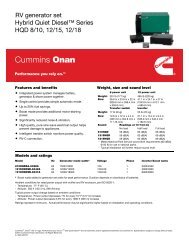Air Brake Manual
Air Brake Manual
Air Brake Manual
You also want an ePaper? Increase the reach of your titles
YUMPU automatically turns print PDFs into web optimized ePapers that Google loves.
said that brake lag is the time it takes the air to<br />
travel through a properly maintained air brake<br />
system (approximately<br />
4/10 of a second).<br />
Braking distance: The actual distance the vehicle<br />
travels after the brake is applied until the vehicle<br />
stops.<br />
The distance depends on the ability of the brake<br />
lining to produce friction, the brake drums to<br />
dissipate heat and the tires to grip the road.<br />
Drivers should never take their brakes for granted.<br />
The braking system must be tested and the<br />
adjustment checked before placing the vehicle into<br />
service. Drivers must understand the braking<br />
system, realize its capabilities and limitations, and<br />
learn to use them to the best advantage.<br />
Heavy vehicles require powerful braking systems<br />
that are obtained by use of mechanical leverage and<br />
air pressure. <strong>Brake</strong>s must be used keeping in mind<br />
the heat generated by friction. If the heat becomes<br />
too great, braking effectiveness will be lost. The<br />
heavier the load and the faster the speed, the<br />
greater the force needed to stop.<br />
It is important to remember that an air brake<br />
equipped vehicle, even with properly adjusted<br />
brakes, will not stop as quickly as a passenger car.<br />
Comparative Stopping Distances<br />
Passenger<br />
car<br />
Loaded<br />
truck<br />
<strong>Brake</strong>s applied<br />
Section Summary Questions<br />
1. What is the final factor that will determine if the<br />
vehicle will move<br />
2. What is the final factor that will determine if the<br />
vehicle will stop<br />
3. How is the heat that is generated by the brakes<br />
dissipated<br />
4. If one set of brake shoes is poorly adjusted,<br />
what effect could it have on the remaining sets<br />
of brake shoes in the system<br />
5. What is meant by the term “friction”<br />
6. If the weight of the vehicle is doubled, how<br />
many times must the stopping power be<br />
increased<br />
7. If the speed of the vehicle is doubled, how many<br />
times must the stopping power be increased to<br />
be able to stop at the same distance<br />
8. If both weight and speed of the vehicle are<br />
doubled, how many times must the stopping<br />
power be increased to stop at the same<br />
distance<br />
9. What is compressed air<br />
10. What does the abbreviation “psi” stand for<br />
11. If 40 psi is exerted against a diaphragm of 30<br />
square inches in area, what are the total<br />
pounds of force that could be exerted<br />
12. Stopping distance consists of what three<br />
factors<br />
13. Define the following terms<br />
“Driver’s Reaction Time” - “Braking Distance” -<br />
“<strong>Brake</strong> Lag.”<br />
Actual stop<br />
Actual stop<br />
9




